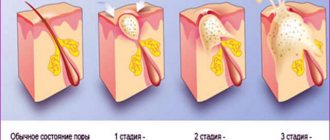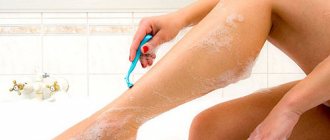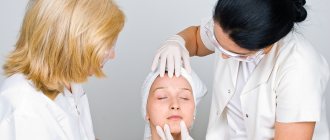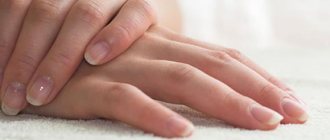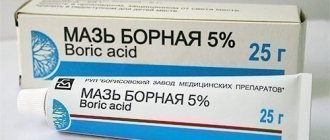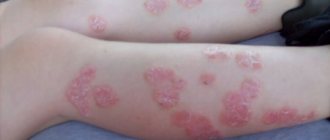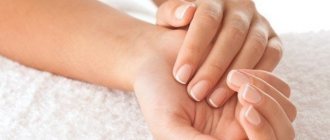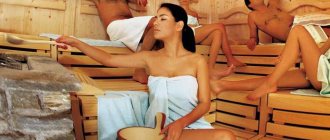Choosing an ointment for calluses on the feet: a review of effective gels, ointments and creams
Callus ointment is a medicinal or cosmetic product for painless removal. It contains ingredients of both plant and synthetic origin. They help exfoliate dead cells and remove them from the surface of the skin. Course use of ointments helps not only to get rid of calluses, but also to prevent their occurrence. At the same time, the condition of the skin improves - it is moisturized and saturated with useful substances.
Pharmacies offer a variety of anti-corn products. They differ in cost, composition and scope of application. Some quickly deal with dry calluses, while others eliminate wet ones. The correct choice of ointment largely determines its therapeutic effectiveness.
What are corns and calluses, signs
The surface layer of skin on a person’s foot is periodically damaged during movement. Constant mechanical irritation leads to the formation of corns and calluses. A corn is a hard formation on the skin that appears as a result of the death of cells and their accumulation in the area of damage.
The keratinization of the skin is accompanied by pain and discomfort. The appearance of corns is similar to a callus.
Types of corns:
- Core (hardening on the skin without a clear boundary, in the center of the rough skin there is a dense core).
- Plantar.
- Finger (growths form between the fingers on the inside).
Causes and types of calluses on the feet
The main reason for the formation of a callus is constant friction or pressure on a certain area of the skin. As a result, its surface layers begin to die off rapidly. In this case, the destroyed cells are not removed in a timely manner, but are layered on top of each other. If dead skin is wetted by sweat, a soft callus will form. And when lymph accumulates under the epidermis, it fills with liquid contents.
Why calluses appear on certain parts of the body:
- feet. A common reason for such localization of damage is wearing uncomfortable shoes. Due to the thin sole, the forefoot is strongly compressed. And the presence of rough internal seams can cause chafing of the toes and heels;
- brushes Most often, cell death is caused by friction with construction or garden tools. Beginning athletes develop calluses when using tennis rackets or hockey sticks.
Pathological causes of callus formation include abnormal gait and valgus deformity of the foot. Inflammatory as well as degenerative-dystrophic pathologies predispose to their appearance.
Patients with bursitis, arthritis, deforming osteoarthritis, flat feet, and heel spurs often suffer from calluses. Their appearance is also provoked by scoliosis, due to which the load on the feet is incorrectly distributed when walking.

One of the most common causes of blisters is incorrectly chosen shoes.
Procedure for applying ointments
To increase the effectiveness of the drug, feet with corns should be prepared. Wash limbs for 10-15 minutes. steam in a hot soda solution (1 tablespoon of baking soda per 2 liters of water). After the procedure, the feet are thoroughly dried with a dry towel.
The ointment is carefully applied to the damaged area, trying not to get on healthy epidermal tissue. In some cases, the ointment is applied to a gauze pad and a compress is made using plastic film. Keep the ointment on the affected areas for 2 to 10 hours, according to the instructions. During this period, keratolysis occurs - the separation of dead cells, their separation from healthy tissue.
Softened exfoliated formations are removed using a brush, pumice stone or special devices included with the medicine. Dead skin areas are removed carefully, taking care not to damage healthy areas of the sole. Treated feet are lubricated with a cream with a moisturizing, regenerating and antibacterial effect.
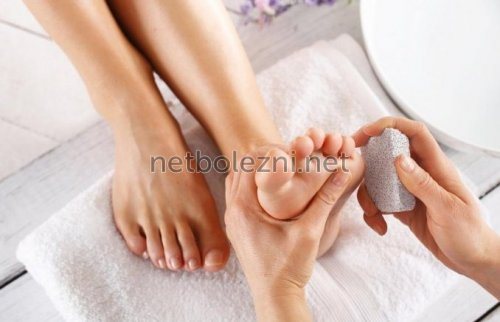
How to choose a remedy for calluses
It’s not difficult to find a high-quality cream for calluses on your feet or hands. First, you need to decide on the type of callus. To remove moisture, products with antimicrobial and drying components are required. These are zinc, phytoextracts of chamomile, string, celandine, lanolin, sea buckthorn oil and others. And salicylic acid and urea do an excellent job with rough corns.
Secondly, when choosing, you need to take into account the speed of the therapeutic effect. Some ointments gently exfoliate the keratinized epithelium, completely removing it in 3-4 weeks. And others, in a couple of days, painlessly flatten the callus and evacuate its contents to the surface.
It is not advisable to pay attention to cost. The price of good fast-acting anti-corn agents often does not exceed 100-150 rubles. At the same time, they immediately exhibit therapeutic effects, are well absorbed and are well tolerated.
Preparations with urea
Super Antimozolin cream - contains urea and lactic acid. Organic acid penetrates deeply into the dermis and can soften the core processes. With the help of the product you can effectively treat corns on the feet. The cream is applied to clean skin of problem areas of the feet in a thin layer and fixed. Insulate the foot with socks, leave it overnight, and treat it with pumice in the morning. The average cost is 150 rubles.
Lekker-Stopmosol ointment contains urea and lactic acid. The product softens keratinized formations, relieves inflammation, and restores the integrity of the skin.
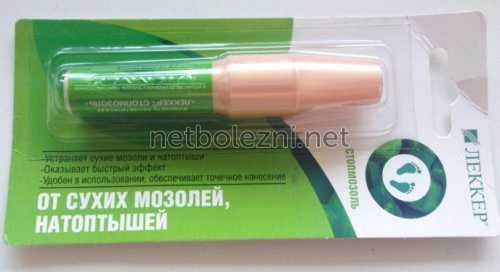
The medicine is applied to the affected area 3 times a day, massaged until completely absorbed. Exfoliated areas of skin are scraped off with pumice and treated with a restorative cream. Price 120 rub.
How to use
Since the areas of application of anti-corn agents differ, the methods of their use also differ. Some of them contain caustic substances, so healthy skin needs protection. Such gels or creams are applied pointwise to the callus, rubbing in with a cotton swab. Manufacturers even recommend pre-sticking an adhesive plaster with a hole cut out.
Treating minor skin damage is much easier. For example, for mildly expressed corns, it is enough to lubricate them with cream 1-3 times a day. They gradually dissolve, decrease in size, and disappear.
If the callus is not wet, then preliminary steaming is recommended, including in infusions of medicinal herbs. Then the roughened area of skin needs to be dried and, if possible, treated with a scraper or file.
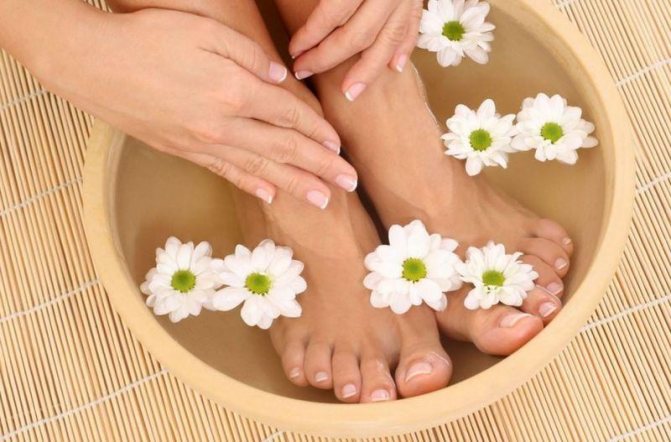
Before using the anti-callus product, it is advisable to steam your feet.
How to use salicylic acid
Each of the above remedies is used at least twice a day. Salicylic ointment and balsamic liniment require a gauze bandage to be applied over the preparation. Keratolytic drugs must be applied with gloves, having previously protected the healthy surface of the skin with a rich cream.
The medicine for corns should be applied directly to the resulting defect. In order for the active substances to penetrate faster and deeper, it is important to properly prepare the skin. The first step is to remove dead skin. This can be done with a pumice stone, a special file or scrub. After which you need to steam
feet. To do this, use hot foot baths. The duration of the process is from 30 to 40 minutes. Hot water must be added during the process.
Judging by user reviews, a simple and effective remedy for corns is salicylic ointment.
It is the basis of keratolytic medications that eliminate skin defects on the foot. The acid softens the callus. It should be applied to the corn itself. After applying the ointment, for the patient’s convenience, secure with a band-aid.
The ointment has advantages:
- cheap;
- safe;
- possible during pregnancy and lactation.
Apply ointment 2 times a day. The course of therapy depends on the size of the callus, usually 7-9 days.
It is absorbed into the blood in large doses. Pregnant women should use no more than 1 gram during a single treatment of the affected area.
Use is prohibited when:
- kidney diseases;
- with individual sensitivity of the drug.
Beeswax should not be used on patients prone to allergies. Foot creams for corns with Vaseline and salicylic acid are not used by people with high sensitivity to these components.
Side effects arise from their use:
- itching;
- burning;
- allergic reactions.
In such cases, use of the product should be interrupted. Creams for dry calluses do not cause allergies, but provide a healing effect.
With regular use of remedies for corns, you can get rid of unpleasant defects and make the skin on your heels as soft as a baby's.
Article verified
by the editors
The best ointments and creams for calluses
Ointment for calluses on the feet or hands can be a pharmacological drug or a dietary supplement (dietary supplement). There are also parapharmaceuticals, for example, Aquapeeling or Neutrogena. It is better not to use dietary supplements at the initial stages of therapy. They will be useful in the final stage of treatment due to their regenerating effect.
Aqua peeling
Ointment for calluses on the feet Aquapeeling is used for rough skin on the feet, corns and seals. It has a rich but not greasy texture and is well absorbed into the skin. The therapeutic effectiveness of Aquapeeling is based on the high urea content (40%). Its effect is complemented and enhanced by extracts of green tea and chamomile, lactic and stearic acid. And lavender and eucalyptus oils eliminate unpleasant foot odor.
Before 6 years of age, the product should not be used due to the risk of side effects of urea. Apply it once a day in a thick layer to the callus or corn, including under an occlusive dressing. The cost is about 200 rubles.
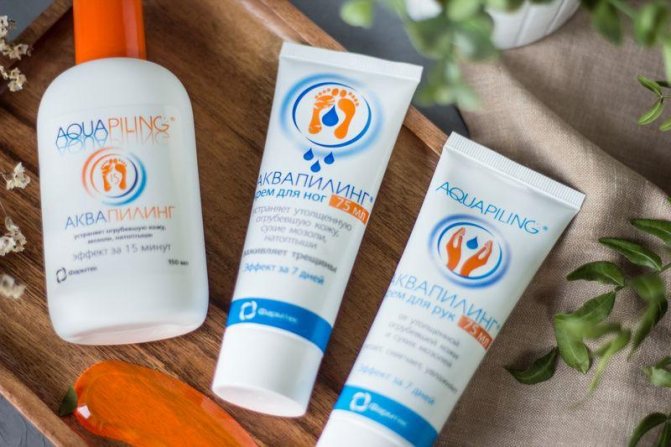
Aquapeeling series of products for skin care of feet and hands
Neutrogena
This is a Norwegian cosmetic product designed to care for dry skin. The brand was created in the 50s of the XX century and remains popular in Europe and America. All products contain a large number of natural ingredients and a minimum of preservatives. Due to the high concentration of urea, they perfectly moisturize and regenerate the skin. Therefore, one of the ranges of their use is the elimination of dry calluses.
Neutrogena is rubbed directly into rough skin 1-2 times a day. Its disadvantages include excess oiliness, shine on the heels or toes. The price of foot products starts from 300 rubles.
Traditional methods
For fans of treatment with natural remedies, we can recommend several effective and safe alternative medicine recipes. For therapy, mainly herbal remedies are used in the form of baths and lotions.
You can quickly soften the keratinized area using oils:
- olive;
- castor oil (it is recommended to use a mixture of glycerin and castor oil in a 1:1 ratio);
- linen;
- corn
It is recommended to carry out the procedure as follows:
- socks made of natural fabric are soaked in oil and put on the feet;
- the feet are wrapped in cling film and covered with a cloth (you can put on clean socks);
- The oil compress is left overnight.
In the morning, you need to wash your feet and carefully peel off the exfoliated soft parts of the skin using a pumice stone, and then apply a moisturizer.
Baths
As an independent remedy, foot baths are effective for small corns. To soften tumors the following are used:
- Soap and soda solution. 3 parts baking soda and 1 part soap dissolve in hot water. The duration of the session is 30 minutes, after which the steamed growth can be easily removed using pumice.
- Curdled milk or whey. Fermented milk products have an active softening effect. Heat the serum and keep your feet in it for 30–40 minutes, then dry (no need to wipe) and lubricate with moisturizer.
- Hydrogen peroxide. The solution is made at the rate of 2 tbsp. l of substance per liter of water. Steaming duration is 40 minutes. After the end of the session, problem areas can be easily removed.
Using masks can eliminate the problem and improve the condition of the skin. The following formulations are recommended for therapy:
- Brewed ivy. Pour boiling water over the herb and leave until cool. Grind the cooled plant material and apply the resulting pulp to the area of the skin defect for 30 minutes. Ivy decoction can be used to wash feet or for baths.
- Potato peel and flaxseed. 100 g peel and 2 tbsp. l. Boil the seeds for half an hour and chop. Apply the resulting cooled mass to the corns and leave for half an hour.
- Sugar, saltpeter and tar. The ingredients are mixed in equal parts, the mixture is applied to the corns for an hour.
After washing off the masks, you need to lubricate the skin of your feet with softening and moisturizing creams.
Lotions
The easiest way to fix the problem: apply the selected product to the corns and fix it with a band-aid.
You can apply to the skin growth:
- raw potatoes (gruel or root plate);
- aloe leaf;
- slice of lemon.
After removing the lotion, the rough skin is easily removed.
Treatment of wet calluses
A wet callus is a blister filled with serous fluid. If it opens prematurely, a wound forms in its place. It is better not to use any means until the bubble collapses. They are necessary when the wound becomes infected to destroy epidermal or Staphylococcus aureus.
Which ointments are most effective for healing calluses on the feet:
- balsamic liniment according to Vishnevsky;
- Syntomycin ointment;
- Tetracycline;
- Salicylic;
- Vitaon.
But it is best to use time-tested Levomekol. The cream is ideal for calluses on the hands, heels and toes. Chloramphenicol from its composition inhibits infectious agents, eliminating inflammation. And methyluracil stimulates accelerated restoration of damaged tissues.
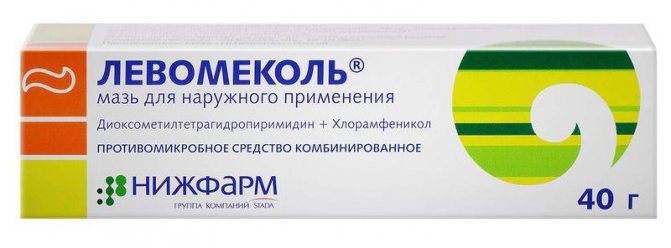
A drug with a wide range of indications, used, among other things, in the treatment of inflamed calluses
What other means are there?
There are alternative products to creams and ointments that can help you quickly remove corns at home. They are also sold in pharmacies. The most effective ones include patches and pencils.
There are several manufacturers of anti-callus patches.
- Salipod. One of the most effective and popular remedies. It has an antiseptic and keratolytic effect. The main active ingredient is salicylic acid. During the time the patch is applied, it penetrates deep into the stratum corneum and softens it. After this, you can remove the patch with the callus. Due to the presence of an antimicrobial effect, the development of pathogenic microflora is prevented. The sulfur contained in the product dries the epidermis well.
- Urgo. It contains many useful components that nourish and restore rough skin. The main one is wheat germ. It also has a keratolytic effect, removing corns.
- Compid. The peculiarity of this patch is: the possibility of use for several days, a greasy texture that nourishes the skin and a quick effect. There are several types of patches that are designed to remove calluses on different parts of the feet.
- Shuyangxuan. Belongs to the group of Chinese medicine and is used for six days. During this time, the stratum corneum will become soft, and after a few days it will completely peel off. Before using the product, you need to steam your feet well.
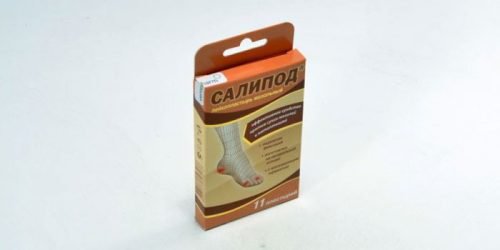
Salipod is one of the most popular remedies
What is the effect of pencils
Special pencils for corns are also popular. These are relatively new products with a quick effect. They are also called refrigerants.
- Cryopharma. Used to perform cryotherapy at home. Using a special applicator, the substance is applied to the site of the growth, after which a bubble with liquid is formed. After some time, it dries and falls off, maintaining healthy skin.
- Wartner. The drug is in the form of a pen applicator, intended for dry calluses. After application, it quickly penetrates into the deep layers of the epidermis and dries. The course of treatment is 4 days. The gel is applied in the morning and evening. Dead cells can be removed using pumice.
- Compid. The products of this company are of very high quality, so you can get rid of corns quickly and effectively. The substance does not leave traces, which allows you to wear shoes without socks. And the product also helps reduce pressure on the skin and its friction.
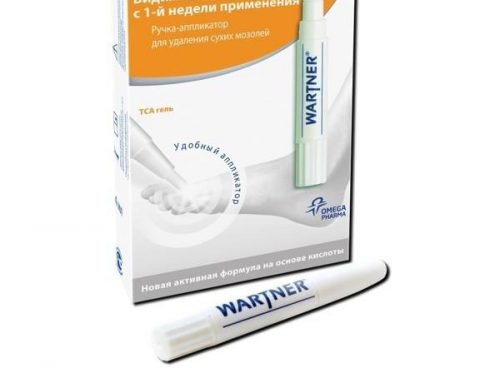
Wartner for calluses comes in the form of a convenient applicator
Treatment of dry calluses and corns
A dry callus is a dense, limited area of dead skin. Its regular treatment with external agents leads to a gradual reduction and dissolution. But in some cases, surgical excision of severely thickened skin is necessary.
There are a lot of high-quality ointments for dry calluses on the feet in pharmacies:
- Aqua peeling;
- Solomeya;
- Mozolin;
- 5 days;
- Super antimozolin;
- Non-callus;
- Callus from the 911 series;
- Medicine with urea;
- 5D five days anti-callus paste;
Salicylic ointment or paste is also used to remove dry calluses. The acid contained in it remarkably exfoliates the keratinized epidermis. And in its place, new, young and healthy cells begin to form.
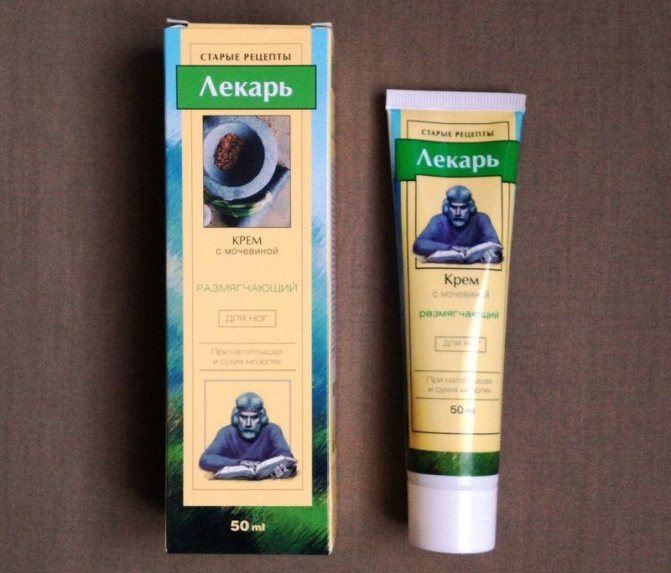
Cream containing urea provides hydration and softening of rough skin.
Treatment for corns on the feet is quick. Removal using anti-callus creams, ointments or patches
You can buy remedies for calluses on the feet at a pharmacy, where they are available without a prescription. The most convenient form of release of such drugs is creams or ointments. They act due to acids, salicylic or benzoic. Some of them contain several types of active components that destroy the stratum corneum and thereby remove the growth. Such preparations should be applied directly to the callus, avoiding contact with healthy tissue.
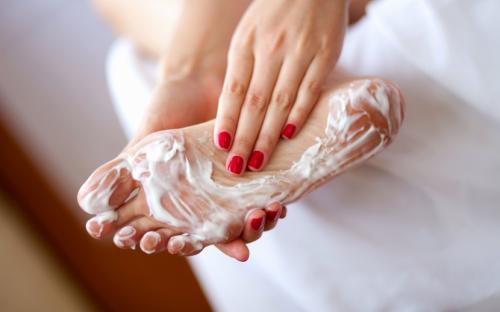
photo from the site vpaintballe.ru
Before applying the cream you should:
- Dip the affected limb in water with the antibacterial solution contained in it and steam it. This will help soften and quickly remove the stratum corneum.
- Cut a hole in the patch according to the size of the formation and glue it, thereby protecting healthy areas of the skin. If you don’t have a patch, you can lubricate the tissue around the growth with petroleum jelly or greasy cream.
- Apply the medicine in a thin or thick layer using a cotton swab, using the instructions for the medicine.
- Place a patch on top and let the medicine absorb.
If painful corns appear on the feet, quick treatment can be carried out using a special patch. It contains salicylic acid and propolis, which help quickly eliminate dead skin and have an antibacterial effect. The patch should be applied to the formation after steaming the skin, leaving it there for several hours or days. After removing the callus, the wound should be treated with an antiseptic and a regular bandage should be applied to protect it from infection.

Folk remedies
At home, fairly effective ointments are prepared for calluses on the toes, heels, and arches of the feet. A handful of fresh calendula flowers and a couple of large plantain leaves are ground in a mortar. Add 2 drops of rosemary essential oil and a pinch of salicylic acid into a homogeneous mass. Then add 50 g of fatty baby cream. Rub this ointment into dry calluses 2-3 times a day.
A time-tested remedy is baked onions. It is crushed to a paste and spread in a thick layer on the calluses. Place a plastic film on top and wrap it with a bandage. Remove the compress after 3-4 hours, remove the softened tissue with pumice.
The most effective drugs against worms
Foot cream, which has a keratolytic effect on corns, easily softens roughness. Dead cells are removed due to the following composition of the product:
- urea;
- lanolin;
- petrolatum;
- plant extracts;
- salicylic acid.
The cream is applied to the area where the callus is located. Manipulations are not carried out on an undamaged surface to avoid injury. A greasy product is applied around the growth.
Advantages:
- naturalness;
- effectiveness in a short time;
- therapy is carried out independently;
- low cost.
Minuses:
- the need to protect healthy skin;
- allergy to individual components;
- Regular use of the cream substance is necessary.
The skin on your legs will heal faster if you use effective medications in a timely manner.
Remedies for corns
| Name | Active substance | Effect | Well | How to use |
| Bensalitin | benzoic acid, salicylic | softens hard callus layer | 1-6 days | every two hours |
| Super antimozolin | salicylic, lactic acid | eliminates calluses, unpleasant odor | 5-10 days | Apply as a compress for 6-7 hours |
| Pasta 5 days | salicylic acid, lanolin, petroleum jelly | softening effect on rough skin of the foot | 5-7 days | 2-3 times a day |
| Nezosol | salicylic acid, sulfur | promotes softening and separation of calluses | 3-5 days | Apply at night to clean skin |
| Crown of Siberia | fly agaric, horsetail, essential oils | For calluses, removes fungus, sweating | 14 days | 2 times a day |
| Gehwol Fusskraft bambus tincture – peeling | bamboo powder in combination with honey extract | strong penetrating effect, quickly softens rough areas | 4 days | 2 times a day, cover with a bandage |
Regular use of the drugs will allow you to remove corns in a short time.
According to user reviews, Biogel ointment is popular. It is positioned as a cheap at-home alternative to pedicures that can remove calluses on your heels and feet. There is one drawback - the chemical composition.
A popular tool for removing defects is the Wartner gel applicator pen. Contains trichloroacetic acid.
TianDe snake oil cream is used. Suitable for every day use. Has an antibacterial, healing effect, eliminates roughness. Exfoliated parts of the callus are removed with foot scrubs.
Many people prefer to use keratolytic cream.
On pharmacy shelves you can find many wide-spectrum drugs designed to combat parasites. Some of them have repeatedly proven their effectiveness and are successfully used in medical practice. Let's consider the most popular means.
Dekaris and Nemozol
Both drugs are similar in their principle of action. They paralyze helminths, which prevents their reproduction in the human body. As a rule, they are taken in combination. First, the patient drinks Dekaris, which stops the activity of parasites, and Nemozol, which is drunk three days later, which helps destroy the parasites.
Pirantel
The drug acts directly on the nerve endings of helminths, and its main purpose is to combat ascariasis and enterobiasis. It is distinguished by its gentle action and is often prescribed for the treatment of children over six months of age. It is also used to treat helminths in pregnant women and new mothers, but in the latter case, consultation with a doctor is required, and breastfeeding will also need to be stopped.
Vermox
A “lighter” analogue of Nemozol, which will be most effective against enterobiasis and trichuriasis. Can be used from 2 years of age, but is strictly contraindicated for people with liver failure, Crohn's disease and other disorders of the body's excretory system. The main benefit is that 90% of the drug is eliminated from the body during urination and bowel movements. Safe for children and can be used by pregnant women, but only after consulting a doctor.
Albendazole
In addition to a wide spectrum of action, the drug is used to get rid of tissue parasites, echinococci, tapeworms, etc. The drug actively spreads throughout the body and penetrates directly into the bodies of helminths, destroying them from the inside. It is excreted from the body along with bile and a little in urine. Albendazole is contraindicated in pregnant women and people with impaired functioning of the kidneys, gallbladder and liver. During use, constant monitoring by a doctor is necessary, especially by a gastroenterologist.
The drug is intended primarily to combat parasites that live in the intestines (roundworms). It affects the nervous system of parasites, which causes paralysis, after which they can no longer attach to the intestinal walls. The drug is not absorbed into the intestinal wall and acts exclusively on parasites.
We suggest you read: Drug treatment of arthrosis of the knee joint
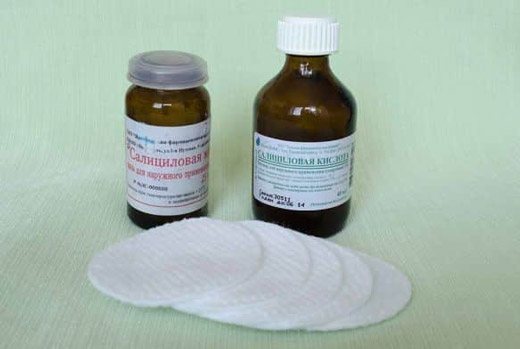
Carbendacim is not used during pregnancy, is not prescribed to children under three years of age, or during breastfeeding. The dosage is calculated individually, taking into account the characteristics of the patient’s body.
Cosmo recommends
Gel polish won't stick! What other procedures cannot be done during menstruation?
Who repeats: star children and their parents with the same beauty techniques
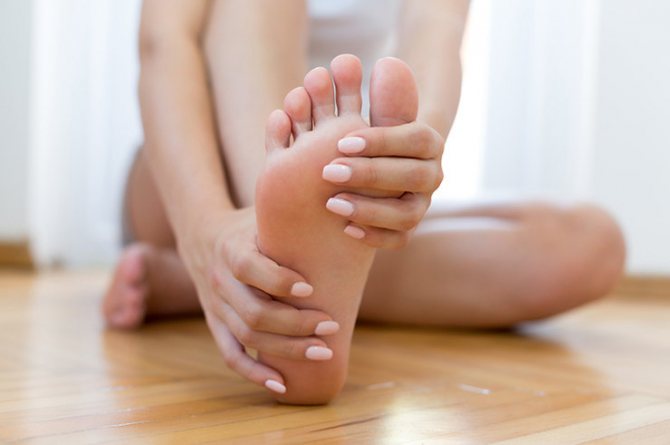
Calluses are a common problem for many girls. Incorrectly chosen shoes or prolonged walking can lead to pain and skin deformities. If the case is not too advanced, then the callus can be cured at home with pharmaceuticals and improvised means, otherwise you should seek help from a specialist.
Treatment
To remove corns, it is necessary to take a responsible approach to the choice of treatment methods. You can combat the problem using simple remedies from a pharmacy or traditional medicine recipes, or using special procedures in beauty salons or medical institutions.
Medicines
The pharmacy chain sells many medications, after using which the corns disappear in the shortest possible time.
The most effective drugs include:
- Anti-callus patches. They help remove thickened skin in just a few days. To achieve a positive result, you simply need to stick the patch to the problem area of the foot and change it according to the instructions. The most popular products from this group are Compid, Leiko, Salipod.
- Salicylic ointment. A good drug against corns, which softens the skin, produces a disinfectant effect and accelerates wound healing.
- Bensalitin. This anti-callus ointment contains salicylic and benzoic acid, which help soften the skin and remove dead tissue .
- Wartner. This is a special pen applicator designed for targeted application of the medicinal composition to problem areas of the body. It helps to quickly soften the skin and remove dead skin particles without affecting healthy areas.
Cosmetical tools
In addition to medications, there are many effective cosmetic products on the market that help in the fight against corns:
- Cream Doctor. Has a natural composition; The main ingredients are herbal extracts. Thanks to the presence of urea, the product corrodes compacted areas and eliminates pain.
- Cream for rough skin from Avon. It helps prevent the formation of corns especially well, perfectly moisturizes the skin and softens dead tissue.
- Super antimozolin. The basis of the cream is urea and lactic acid. The product helps remove corns and eliminates unpleasant odor.
- Crown of Siberia. Contains extracts of horsetail and fly agaric. Thanks to carefully selected components, the cream can be used to treat fungal infections and to get rid of excessive sweating of the feet .
- Green Planet. The cream contains lactic acid and natural oils. It perfectly moisturizes and softens the skin, and can be used as a therapeutic or prophylactic agent.
- A unique Chinese remedy containing snake fat. It helps remove dead skin tissue and speeds up the healing of damaged skin.
Application of hardware treatment methods
The easiest way to get rid of unpleasant corns is to seek help from specialists. For treatment, they use special devices with different operating principles. Literally after the first use, all keratinized tissue on the surface of the legs will be removed. The following techniques are most often practiced in salons:
- Hardware pedicure. The most popular and safest way to get rid of the problem. The keratinized tissue is removed by grinding. During the procedure, the person does not feel pain, but several therapy sessions may be necessary to achieve a good result.
- Laser removal. Expensive but effective procedure. When exposed to a laser, rough tissue is eliminated, while healthy tissue remains untouched. The manipulation does not cause pain.
- Cryodestruction. Rarely used due to the pain of the procedure . It involves treating problem areas with liquid nitrogen. A dense crust forms at the burn site, which gradually disappears. After a week, the skin becomes smooth and gets rid of dead tissue.
Treatment at home
There are many effective folk remedies that get rid of rough skin in the shortest possible time:
- Onion compress. Finely chopped onion should be applied to problem areas. For fixation, use cellophane and additionally wear warm socks. Manipulation is best done in the evening before bedtime. In the morning, the compress is removed, the softened tissue is removed with pumice.
- Apple cider vinegar and eggs. You need to mix one egg, one tablespoon each of apple cider vinegar and sunflower oil. The freshly prepared mixture is applied to the skin in the evening, fixed with a bandage and left overnight. In the morning after the procedure, wash your feet and keep them in a small bath with soda and salt added. The softened tissues are removed with pumice and a nourishing cream is applied.
- Therapeutic wraps. You need to take high-quality tomato paste (preferably homemade), coat your feet with it, wrap it in plastic and put on socks. Keep the compress all night, and in the morning the dead skin areas are removed.
- Serum bath. You can also use regular sour milk or kefir . The dairy product is heated and the legs are dipped in it for 30 minutes. After the procedure, problem areas are treated with a mixture of glycerin and castor oil in a 1:1 ratio.
- Softening foot bath. Add a tablespoon of grated laundry soap, the same amount of baking soda and half a teaspoon of ammonia to a small amount of hot water (enough to immerse your feet). After 35 minutes, the legs are removed and the softened skin is removed using pumice.
- Lemon compress. Peel the citrus and apply a piece to the problem area. Keep the compress all night, and in the morning, use pumice to remove the skin that has been softened.
- Healing cake. It is necessary to mix a small amount of vegetable oil, honey, bran and rye flour. You need to get a thick mass, which in consistency resembles thick dough. The cake is applied to the corns, fixed with cellophane, socks are put on and they go to bed. In the morning, remove the compress and remove the softened areas.
How to quickly get rid of calluses at home
Treating water (wet) callus on the heel
Water calluses appear in the heel area or near the Achilles tendon. If the capillaries are affected, the callus will be bloody. Most often, a wet callus occurs as a result of friction and wearing tight shoes.
To get rid of a callus on your heel, follow these steps:
- Wash your foot carefully so that the callus does not burst.
- Apply a special patch for wet calluses.
- Make a pillow from sterile gauze pads.
- Apply to the bubble and secure with a regular band-aid.
- Change the bandage 2 times a day, morning and evening.
- Do not puncture the callus, otherwise there will be a risk of infection.
- If the callus bursts on its own, do not touch the pieces of skin: they serve as protection.
- Wash the callus with chlorhexidine and change the gauze bandage regularly.
- If suppuration occurs, consult a doctor immediately.
How to brush your teeth correctly: the secrets of a beautiful smile
Getting rid of dry calluses
A dry callus looks like a small yellowish bump on the skin; it doesn’t hurt much. It occurs from wearing uncomfortable shoes and can develop into a water callus if proper measures are not taken.
Removing dry callus:
- Dilute a bath with warm water, sea salt and soda before going to bed. For 3 liters of water, 1 tablespoon of salt and the same amount of soda.
- Steam your feet for 10-15 minutes, then wipe dry with paper napkins and scrape the callus with a cotton pad or a wooden stick.
- Lubricate the area of damaged skin with zinc paste and try to exfoliate the dead skin. If the callus does come off, leaving a pink mark, then use a rich baby cream. After the procedure, blot off excess cream with napkins and put on socks. If necessary, repeat the procedure after 3-4 days.

How to cure callus
Calluses most often form on the toes. Outwardly, it resembles a dry callus, but has a hole in the middle and affects much deeper layers of the epidermis. Occurs from wearing tight shoes. At home, you can get rid of such calluses using a patch with salicylic acid, which is sold at the pharmacy. It is recommended to wear this patch for 1-2 days and reapply if necessary. You should not try to open the callus yourself, this is fraught with complications.
How to get rid of calluses on your toes
Calluses on the toes are not easy to treat due to constant friction against the inner edge of the shoe. The fastest way to get rid of calluses on your fingers is to walk barefoot or wear open shoes. In other cases, you will have to intervene with the use of pharmaceuticals.
How to get rid of a callus on the little toe
These calluses look like hardened blisters on the very phalanx of the finger. You can get rid of calluses on the little finger using a protective pad of gauze and cotton wool. You need to rinse your finger with warm water, wipe it with a cotton pad with chlorhexidine and lubricate the area with callus ointment, which is sold in any pharmacy. Attach a pad of gauze and cotton wool to the surface of the damaged area using a bactericidal patch. It is important to isolate the rubbed little finger from its healthy counterparts to ensure quick and comfortable healing.
How to get rid of dry calluses on the soles
Calluses on the soles occur due to tight shoes or thin insoles that do not absorb the step, causing the foot to hit the asphalt with special force. Depending on the type of callus (dry or water), treat the sole using the appropriate method described earlier, wrap it tightly with a bandage around it or secure a wide piece of bactericidal plaster over the entire surface of the damaged area.
How to get rid of corns on the feet
Corns occur due to the greatest pressure on an area of skin. They most often appear on the heels, between the toes and on the foot under the toes. The formation of corns is usually associated with flat feet and wearing high-heeled shoes.
- Soak your feet in hot water with sea salt and remove the layer of dead skin with a washcloth and pumice stone.
- The pharmacy sells products for effective foot peeling, which are based on urea, which is necessary to soften skin deformations.
- Use special plasters specifically for the foot area and cotton wool and gauze pads to reduce pressure on the affected area of the skin.
How to get rid of a callus on your foot
Hard shoe bridges can damage the top or side of the foot, where the skin is much more delicate. In this case, it is necessary to treat the callus in a more delicate way. Unlike the rough skin of the sole or toes, the top of the foot is much more sensitive. You need to rinse your leg with warm water, clean the wound with hydrogen peroxide and lubricate it with Levomekol or Rescuer ointment. Cover the wound with a piece of gauze and secure it with a thin layer of bandage or a strip of bactericidal plaster. Change the bandage 2 times a day until complete healing.
Description of the disease
Corns appear during the process of keratinization of areas of the skin located in places of regular friction: fingers and heels. Their timely therapy is important to prevent possible complications when cracks, wounds form on the feet and deformation of the foot occurs.
Treatment should be comprehensive and include:
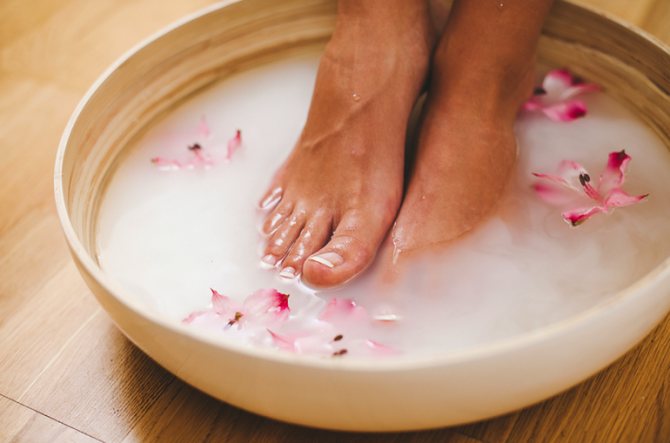
- hygiene procedures;
- medicinal baths;
- medicines for corns on the feet or home remedies.
Cosmetology salons also perform hardware procedures to remove rough skin.
General ointments
These include drugs that are widely used in medicine to heal abrasions, wounds, burns and other injuries.
Salicylic ointment 2% - has a light yellow color and thick consistency. It has an antimicrobial and drying effect, accelerates the process of cell division. Used to treat wet or infected corns. Apply with clean hands or a cotton swab to the callus 2 times a day until the discharge disappears from it. The price ranges from 20 to 30 rubles. per bottle 25 g.
Zinc paste is a white ointment with a thick consistency. It has high bactericidal properties, reduces the release of fluid from the damaged area. Suitable for treating weeping or inflamed corns. It is necessary to anoint the burst callus with a sterile gauze swab and cover it with a bactericidal plaster. The cost of a tube with 10% paste 25 mg is from 30-50 rubles.
Synthomycin ointment is a liniment in the form of a fatty substance. Destroys bacteria on the surface of the skin, moisturizing it. Recommended for getting rid of dry calluses on the toes; you should apply it to the affected areas at night so that the product has time to be completely absorbed. Price – 60-90 rub.
Levomekol - contains an antimicrobial substance (methyluracil) and an antibiotic (chloramphenicol). Used to prevent infection of abrasions on the leg, has a keratoplasty effect. The cost of a 40 g tube is 120-130 rubles.
These ointments are effective mainly for getting rid of wet calluses or inflamed corns. A positive quality is the low price category with significant efficiency.
Hardware pedicure
If self-treatment does not produce visible results within several weeks, you should contact a specialist. The most gentle method is hardware pedicure. Many ladies, who are not even concerned about the problem of corns, regularly do this procedure in the salon, because it is several hours of pleasure, and the result is smooth and soft feet.
To get rid of dry calluses, you should contact a hardware pedicure specialist. This method allows you to remove corns as deeply as possible. The device also drills out calluses with a rod. It is almost impossible to get rid of them on your own, especially in advanced cases. During the procedure there is no discomfort, much less pain.
First of all, the feet are treated with a disinfectant. Then the corns are cleaned off using a fine-grained and coarse-grained drill.
When performing a hardware pedicure, the possibility of infection is excluded. An experienced master always works with gloves. The result of the procedure depends on the device. Good models provide complete removal of corns. If you do a hardware pedicure regularly, then the problem of dry calluses will no longer affect your feet.
Specialized means
The peculiarity of these drugs is the presence of a healing or keratoplasty agent (oils, vitamins A and E) in large doses. The stratum corneum is moistened, followed by softening and easy separation. It is recommended to smear the affected areas once a day before going to bed, which helps the ointment to penetrate to a greater depth.
Rescuer
A balm of wide application, used to treat various skin injuries. Contains natural plant substances:
tea tree extract;
olive oil and beeswax.
The combination of components allows you to use “Rescuer” for corns, blisters, and infected abrasions. If a callus has burst and a wound surface has formed, the balm will promote rapid healing and eliminate pain. Cost – 120-150 rubles.
Callus 911
It is a cream containing:
castor and corn oil;
tea tree extract.
Used to soften calluses on the heels and toes. It is necessary to smear the rough area 2 times a day, actively rubbing the product into the skin. Price – 100-130 rub.
We recommend reading about calluses on the heels: https://plannt.ru/mozoli-na-pyatke
Doctor
The cream contains the active substance urea, which moisturizes the epidermis and softens abrasions on the legs. Excipients (celandine extract, oak bark) have anti-inflammatory properties and relieve pain. The product is recommended for getting rid of calluses of all types.
Treatment of fresh lesions involves rubbing the product into the skin. If abrasions occur or a bubble bursts, additional coverage with a bactericidal plaster is recommended. The price of a 50 ml tube is 150-200 rubles.
Dr. Mozol
Available in a 15 ml plastic jar. Contains:
The combination of active ingredients is highly effective against old calluses (with the formation of a core), against dry corns. It is recommended to anoint the affected area overnight and cover with a regular band-aid. The procedure must be repeated for 7-10 days. Cost – 280-300 rub.
Sophia
The ointment is available in plastic tubes of 125 ml. Contains urea, petroleum jelly, salicylic acid, beeswax and emulsion wax.
The product helps with minor roughening of the skin of the heels and toes. The skin should be treated once a day. Price – 200-250 rub.
Drug therapy
The pharmaceutical industry offers a variety of pharmaceutical products for corns - from ointments to pencils and socks. Each of the proposed products contains active ingredients to eliminate skin keratinization and agents to soften it.
Ointments and creams
Ointment preparations with a keratolytic effect contain various components that help soften and remove the growth:
- salicylic acid;
- lanolin;
- urea;
- snake poison;
- lactic acid;
- urea.
The following products can be purchased in the pharmacy network:
- Super Antimozolin. It is made with the addition of urea and lactic acid.
- Bensalitin. Contains benzoic and salicylic acids.
- Doctor. The active substance is urea.
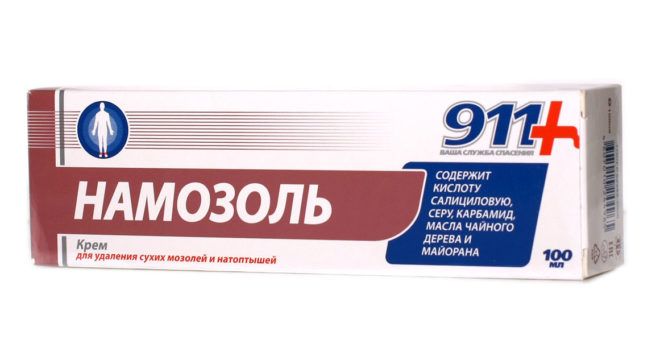
- Nazosol-911. A combined drug that not only softens rough areas, but also promotes wound healing.
- Salicylic ointment. It is considered the most popular for the treatment of dry calluses and corns due to the combination of affordable price and good therapeutic effect.
It is necessary to use ointments to eliminate corns, following the following instructions:
- Steam your legs. It is recommended to add a few drops of iodine, salt or herbal decoctions to the foot bath.
- After steaming, dry your feet with a towel.
- Lubricate a healthy area of skin with Vaseline or cover with a band-aid. This is necessary to prevent damage to the skin by the active components of the ointment.
- Apply the selected composition to the problem area, cover with a napkin and secure with a bandage or plaster.
- After a few hours (the time for each drug is indicated in the instructions for use), remove the bandage and carefully remove the exfoliated areas using pumice.
With regular procedures, skin roughness disappears within 2 weeks.
Plasters
The advantage of using patches with anti-callus impregnation is that they are convenient to use even in hard-to-reach areas (for example, between the fingers).
The following drugs are most often used to eliminate skin defects:
- Salipod;
- Bensalitin;
- Mozolin.

Before gluing the patch, to facilitate the penetration of active substances into the skin layers, it is recommended to take a steaming bath for the feet.
Pencils
A relatively new and not familiar form of release. The convenience of pencils is that you can carry them with you, which allows you to carry out therapy even while away from home. Pharmacies offer two types of pencils:
- WARTNER;
- Compeed.
They are easy to use. You need to “paint” the affected area with the medicine and leave it until it dries, and then clean the exfoliated areas.
Socks
Another effective remedy for corns is Japanese socks. They are available with various impregnations:
- citrus oils;
- burdock;
- chamomile;
- sage;
- lactic acid.
Important! The advantage of using socks is that they not only soften and exfoliate growths, but also improve the overall condition of the skin of the feet, making it softer.
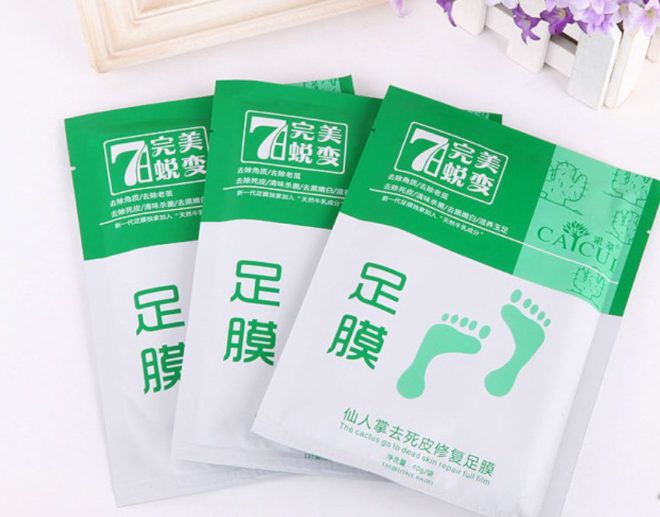
DIY ointment for foot corns
Many people try to avoid going to the pharmacy by using traditional methods, and achieve excellent results. Here are some recipes to combat dry calluses:
Garlic paste
Peel a few cloves of garlic, place them in boiling water for 2-3 minutes, crush them with a garlic press and mix with soft butter. Apply the resulting slurry to clean skin of your feet and cover with polyethylene. After a few hours, the garlic can be removed, the feet can be washed and processed, removing all excess.
Prunes with milk
Pour a small amount of milk over the washed berries and bring to a boil. Then crush the prunes to make a porridge. When warm, apply it to the damaged area, covering it with polyethylene. When the prunes have cooled, after about 20 minutes replace them with a new warm “portion”. The composition should be hot, but not scalding. You need to renew the compress 3 times, then wash and treat the foot.
How to get rid of corns with a stick
To prevent relapse, it is necessary to entrust the removal of the corns to doctors. Only a doctor can guarantee the sterility of the operation and complete removal of the rod, which is located too deep in the soft tissues.
The reasons for the occurrence of this type of dry calluses can be rubbing the skin with uncomfortable shoes and the introduction of a virus. In order to eliminate the problem, you need to follow all the doctor’s recommendations and possibly undergo a long course of treatment.
What methods can you use to get rid of corns on the soles of your feet?
At the initial stage of the disease, independent treatment methods help. More serious cases may require surgery. Let's take a closer look at how to remove dry calluses at the earliest stages of their development.
Before you begin any treatment, find out the cause of the disease.
Scraper removing dry calluses
Before using it, the skin on the legs is well steamed. The scraper gently cleanses the foot of dead skin. There is no need to try to completely get rid of dense areas of skin in one session. It is best to do this gradually over a month. After the procedure, the skin is treated with any antiseptic, then a moisturizing or softening cream is applied.
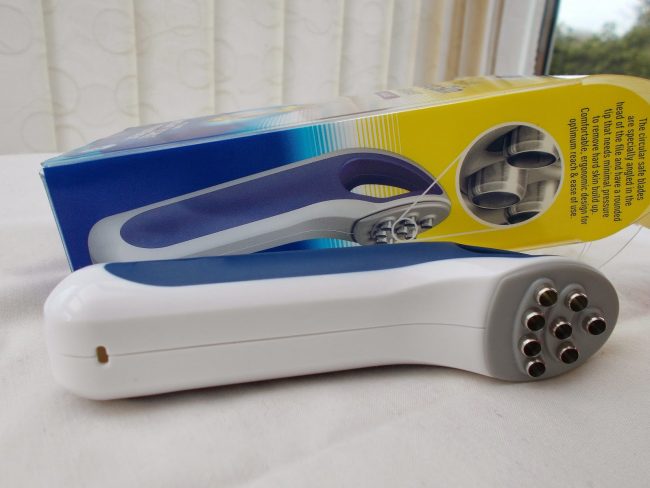
Laser removal
Benefits of laser removal
- This is a bloodless operation;
- During the session, local anesthesia is used, so removal does not cause pain;
- The procedure is carried out quickly;
- To completely get rid of the seal, one laser session is enough;
- After removal, you can move without restrictions;
- Does not leave scars;
- Healthy areas of skin are not damaged;
- The wound heals quickly;
- There is no risk of inflammation or infection.
Contraindications
- Diabetes;
- Oncology;
- Cuts or wounds on the treated area.
The only inconvenience after this method of treatment is that you will have to use an insole or bandage for some time so that there is no pressure on the injured area of the foot.
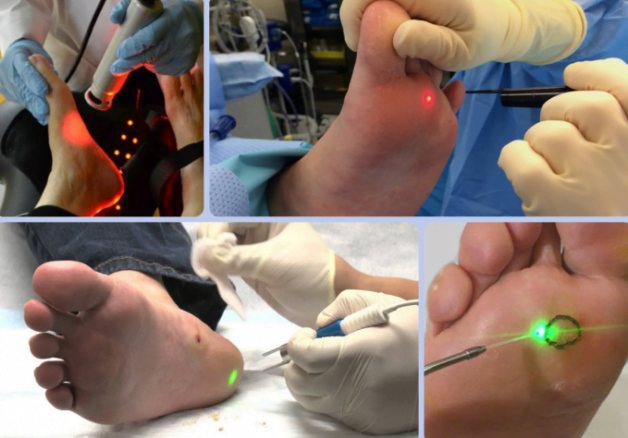
Removal with nitrogen
Liquid nitrogen is used to remove dry calluses. This method is well suited for advanced cases or for removing a rod. The method has negative sides
- During processing, healthy tissue areas may be damaged;
- Painfulness of the method;
- After the procedure, the skin recovers over a long period and requires careful care;
- Only a small area of the foot is treated;
- You cannot remove several corns located nearby - tissue restoration will be painful and too long.

Despite the unpleasant aspects of this method, it also has its advantages.
- No scars remain;
- The recurrence of a dry callus in the same place is unlikely;
- This method is suitable for people for whom anesthesia is contraindicated, since it does not require pain relief;
- Treatment with liquid nitrogen is suitable for almost everyone; it has no contraindications.
To avoid a relapse or an inflammatory process, after removal it is necessary to strictly follow all the doctor’s recommendations.

